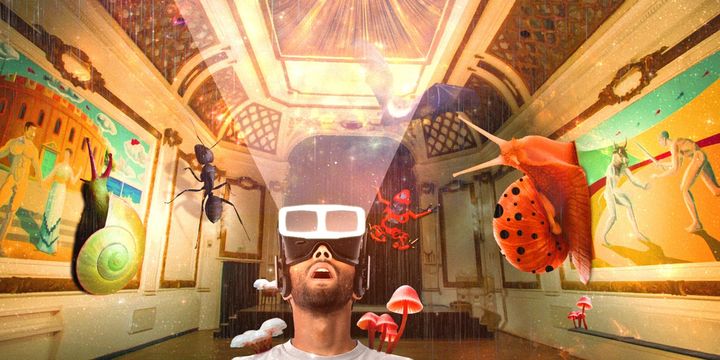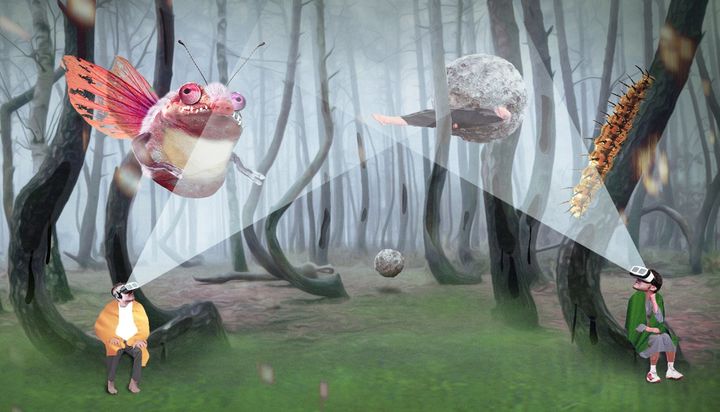One of the great promises of virtual reality is that we will be able to craft lives that play out our wildest fantasies, all with the click of a button. To reach this point, however, the industry will need to harness and deploy elite technical talent and pragmatic operational expertise to make this phenomenon a viable commercial reality. While it’s obvious that top tier engineers and impeccable execution are critical, it’s really the creatives, dreamers, and visionaries that will help us express ourselves fully in this limitless medium.
I recently had the pleasure of interviewing this sort of creative visionary in the VR industry named Louis Cacciuttolo, who founded VRrOOm. In this piece, Louis shares his aspirations, fears, and predictions for virtual reality and explains how VR will enable us to live multiple lives simultaneously.

Live multiple lives in virtual reality.
Please tell us briefly about yourself and VRrOOm. How did you end up in the virtual reality space and what do you want to accomplish with VRrOOm?
I come from a family of artists and travelers. In addition to being a musician, writer and filmmaker, I own a theatre in France (Théâtre du Minotaure, in Béziers). On the corporate side, I have extensive work experience in branding and marketing, having worked for large advertising agencies such as Ogilvy and Saatchi in cities around the world.
Before creating VRrOOm, I worked for THX, a legendary brand with production studio quality standards created by George Lucas. Acting as the Executive VP of Global Branding, I was partially based in San Francisco, a hotbed for the VR industry in the United States. This gave me some initial exposure to the nascent VR space.
One of our key markets was China, a country I know very well as a long time expatriate with Mandarin fluency. While living in China, I saw huge opportunities in the AR/VR space as I was able to combine my background in entertainment, marketing, and technology, while also leveraging my various professional networks in Asia, Europe, and North America.
VRrOOm is a media platform that offers news, guides, and content distribution with the goal of driving mass market adoption of VR. VRrOOm is dedicated to promoting a future in which we lives our lives in virtual reality, through a combination of tech and creativity.
I want VRrOOm to ultimately become ‘The Voice Of VR’

Louis Cacciuttolo
You believe that we are on the verge of a huge revolution with VR. You proposed that VR could become more than just an accessory: it could become actual way of life. Why do you feel this way? In what specific ways do you think people will live their new lives with VR?
For the first time in history, anyone will be able to live their dream life while they’re still alive.
People won’t have to lie on their deathbeds, regretting missed opportunities and chances. VR will provide us with an instantaneous means of transporting ourselves into the life and world we wish we could have built for ourselves. As such, it’s not unreasonable to believe that VR will disrupt everything, including religion.
Previously impossible situations will be immediately possible. Physically disabled people will be able to swim faster than Michael Phelps and sprint faster than Usain Bolt. Working class people in emerging countries will be invited to attend Oscar ceremonies and be able to watch Champions League soccer matches in a virtual skybox while bathing in champagne. It’ll be possible to simultaneously visit Mars, change your gender, or even your skin color. Your mind is the only limit.
On a more practical level, people in the military or dangerous industries will be able to conduct training without risking life and limb.
Ultimately, a new economy will be born out of thin air as some financial constraints in the real world become irrelevant in the virtual world. The very concept of money and trading will also be transformed as the value perception will shift in the same way; for example, diamonds are expensive consumer items in the real world. In VR, they will cost nothing. It is difficult to guess how this will impact the value chain for a wide range of industries.
The term “virtual” could become obsolete. In an ironic twist, a growing number of people and influencers now wonder whether we are not already living in a simulation.
As VR makes dreams come true, our new lives will soon become our ‘preferred reality’.

Explore alternate realities in VR.
We’re still in the early days of VR and haven’t reached mass adoption. What do you think companies need to do to make this industry take off?
What the VR industry needs to reach mass adoption isn’t very different from what any other industry would need: it’s all about educating the market. With VR and AR this task is especially difficult because the entry point is still quite high. Thus, early adopters are still relatively scarce in comparison to the projected potential market for this space.
Ultimately, location-based experiences (LBE) will drive mass market adoption. It’s impossible to understand VR until you’ve actually had a VR experience. This is a constraint right now because driving a mass market adoption strategy with physical locations for free trials is resource, labor, and time intensive. We’d need the same companies currently investing billions in the space to also allocate portions of this money to support market evangelization through physical experiences.
On the other hand, we are talking about redefining realities. The challenge VRrOOm is trying to tackle is to make consumers think in VR, and rather than VR becoming another gadget or mere accessory in one’s life.
VR is all about augmenting our lives. Linden Lab’s naming of their venture “Second Life” was genius, because it goes right down to the essence of what VR is about.
We need to crack the challenge of educating people about leading a double (or second) life as naturally as they are used to in their usual existence; it’s like suddenly being able to breathe water. It’ll take some time for everyone to fully realize the true potential of this revolution, as the experience is quite unnatural. As such, it may take a generation or two before we see society’s mindset and behaviors adapt to VR.
I most likely won’t see it happen, but I am happy to participate in the process. I truly believe the human race is mutating at a very fast space and that VR will be an accelerator of this change.
Another challenge the industry will need to overcome is how to not get constrained by industry standardization and formatting. More than any other medium, VR requires creators to think outside the box. VR should be zany and unpredictable. VR should be wild, high, and witty - it should be like Alice in Wonderland.

One of the main constraints that is holding VR back is a lack of high quality and scalable content. What do you think needs to change to improve the pipeline of high quality VR content?
Indeed, there’s an acute need to drive a scalable quantity of high quality content. We can’t just assume this will happen naturally. In China, for example, a growing number of VR companies are shutting down, despite the hype around this industry. This is largely due to negative consumer experiences with various VR platforms. This is a worrying trend and, to avoid a demise similar to that of 3D television, the industry needs to come together and make sure that VR takes off properly.
You asserted that “VR should be Wild.” You dislike the idea of standardization and formatting of VR. Can you elaborate on this point?
It feels like such a waste to use a new medium in order to just repeat conventional models. The possibilities of VR are infinite; hence, the projects driven by VR should be amazing, other-worldly, and have no limits.
Most professionals in this industry agree that before engaging in a VR project, the first question you ask yourself should be: Could this be as well done with another medium? If the answer is yes, then VR is irrelevant and the project is meaningless.
Creating anything in VR should help the industry move forward, transgress boundaries and explore new possibilities.

Creating experiences for the VR medium is dramatically different than anything we’ve seen before. For the most part, traditional engineers and designers have been having a difficult time creating great experiences in VR. What’s missing? What kind of people need to get involved in the creative process for VR content to truly become seamless?
As in our (real) reality, successful and memorable VR experiences are driven by our senses as much as they are triggered by our imagination.
First, in the real world, we are not tethered to any machine; we are free of most physical constraints. Hence, we need to get rid of cables and cumbersome headsets altogether. VR will have a chance when physical constraints like these are totally removed.
Second, although I am a big movie fan (being a director myself) I find it bizarre that most narrative projects in VR are currently driven by cinema industry professionals. VR is dramatically different from cinema and even CG. Thus, the spatialization must feel real, versus being designed from a flat-screen 3D perspective or from the perspective of a CG environment.
The uncanny valley is not only a matter of how close you get to photorealism (and most VR experiences can feel very real even when using very basic graphics) – but much more about how authentic the experience feels from both a psychological and physical perspective.
As a result of this, choreographers, architects, drama stage directors, and even sportsmen should be involved in the VR creative process, because they deeply understand the challenge of communicating through the medium of the human body and mind.
Finally, our senses dictate our beliefs. Sound is another essential element to complete a powerful and credible VR experience. More often than not, the poor quality of sound accompanying amazing visual performances ends up totally ruining VR experiences. We’re seeing that budgets for VR content creation are largely allocated to image at the expense of sound. Until sound is invested in as heavily as visuals, we won’t reach truly immersive experiences.
In our physical reality, our 5 senses – plus our minds – drive our experiences and make us believe that what we experience is our objective reality. Although some interesting progress is being made in all sensory areas, VR has still a long way to go before we reach a state where it can completely satisfy our five senses: sight, sound, touch, taste and smell. Once this happens, VR will enable us to truly embark upon multiple lives.
I can’t wait for this to happen.
